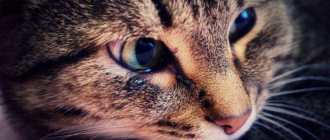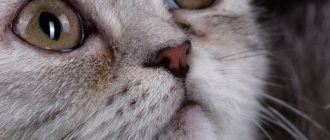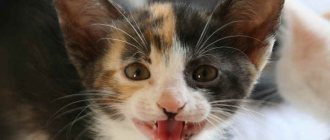Sometimes owners notice that their cats cry. At such moments, you want to hug and reassure your pet, since tears for a person are a sign of serious emotional distress. It is important to understand here that in animals the lacrimation process works a little differently.
The appearance of tear tracks on a fluffy face is very rarely associated with psychological discomfort. More often it indicates the presence of hidden and sluggish diseases that require mandatory treatment.
Causes of tears in cats
The appearance of tears may be a sign of a viral or bacterial infection in the eye. If your pet is crying in one eye, he most likely has conjunctivitis. Only a veterinarian can confirm or refute this possibility after examining the animal. If the diagnosis is confirmed, the doctor will prescribe the necessary treatment. The constant production of tears is sometimes triggered by allergies. Allergens may include household chemicals, dust, food, pollen, your own fur, and in some cases, the owner of the animal. In order for a cat to stop crying, you need to find and eliminate the source of the allergy. An unusual reaction of the animal’s body in the form of secretion of tears may appear due to the proliferation of parasites in it. To help your pet, you need to give him an anthelmintic.
What to do about lacrimation in animals
Possible actions directly depend on the cause. If everything is explained by physiology, then it is enough to wait for the condition to normalize or help your pet with eye hygiene. Special veterinary lotions, herbal decoctions or weak tea leaves are suitable for cleansing.
When pathology is confirmed, it is enough to simply follow medical recommendations. Depending on the diagnosis, a mustachioed pet may be prescribed antibiotics, antivirals, anthelmintics, anti-inflammatory, antihistamines or other drugs.
Possible causes of meowing
To find out the reason for constant meowing, you should take a closer look at the behavior and appearance of your pet.
Moving
Changing the usual way of life, the kitten experiences stress. One obvious cause of anxiety in kittens is separation from their mother. This is especially true for babies who are taken from a cat before the age of three months. The socialization period is not over yet, and the pet feels loneliness and helplessness. The kitten meows loudly, calling the cat for help.
It happens that kittens are taken away at an early age, up to a month. At this time, they do not defecate on their own, cannot maintain body temperature and carry out basic self-care. Kids are cold, they feel discomfort and express it as best they can.
Nutrition
During the suckling period, babies fill their stomachs whenever they want. Left alone at an early age, they loudly moo and announce their desire to eat. Perhaps the matter is in the wrong approach to organizing the diet.
The quality of food also matters. It is worth asking the breeder what diet was offered to the mother and kittens before the sale of the pet and stick to the same “table”. If there is no way to find out how the kitten ate, or the owner has other feeding preferences, it is necessary to properly accustom him to new food and organize the correct diet for him.
Hunger
Why does a little kitten constantly meow? The most common reason for this behavior is... hunger! This is how your new family member will show what he wants to eat.
This phenomenon is quite normal. After all, when a person is hungry, he talks about it. So the animals do the same. Only instead of the speech we are used to, the cute fluffies meow.
Please note: a small kitten will constantly ask its owner to feed it while it is hungry. But adult cats try to meow clearly and just a few times, as if to call their owner to the bowl
Thus, because of hunger, all animals give voice
It doesn't matter what age
Tearing in cats during or after eating
This phenomenon may have several reasons, among which we note:
- breed, genetic predisposition;
- allergies;
- congenital defects of the skull structure;
- blockage of tear ducts;
- unbalanced, low-quality diet;
- eversion, entropion, cataract;
- distichiasis (improper eyelash growth);
- foreign bodies in the eye;
- endocrine diseases, disruptions (diabetes mellitus);
- eye injuries;
- helminthic infestation;
- dacryocystitis (non-infectious inflammation of the lacrimal sac);
- digestive problems;
- close location of the upper teeth to the nerves of the eyes;
- individual, physiological characteristics of the body.
If the cat does not have chronic, acute pathologies, the production of tears while eating is a clear sign of a food allergy. Components, additives of prepared feeds, and food products (liver, beef, legumes, rice, soy, milk) can act as allergens. Especially often, nutritional allergies develop against the background of an unbalanced diet, if the cat is fed low-quality “economy” food.
Breed Features
Tearful discharge from the eyes may appear due to an unusual anatomical structure, for example, in the British and Persians - this is a common occurrence, especially when the owner does not pay due attention to the hygiene of the animal. Also, structural features often cause tears to appear while eating.
Cats have excellent control over their vocal apparatus and often use it for their own purposes. In some cases, pets may cry like children in order to get what they need from the owner. This is blatant extortion on the part of the animal, but, nevertheless, this behavior of the pet works flawlessly
A plaintive meow, similar to the crying of a child, is a kind of trick, an attempt to attract attention to oneself in order to get food faster. Often the pet may begin to cry pitifully in order to get outside
This is also one of the ways of manipulation, because when they walk, they make completely different sounds.
Often, a cat can not only cry, but also throw tantrums while in the car. Getting into a car, the pet is faced not only with limited space, but also with new, in most cases, unpleasant odors. Animals perceive odors much more strongly, so the abundance of chemicals - air freshener, the smell of seats and fuel, leads them to an inadequate state. New sounds of unknown origin also greatly frighten the pet. A cat's ear, unlike a human's, perceives the slightest rustling of mice, so the roar of a running engine leads pets to a state of stress.
Cat tongue
To recognize your cat's mood, you need to observe her behavior and changes in posture. When the cat:
- lies relaxed next to you - the mood is good, playful;
- she lays down with her stomach up - you can pet her;
There is never enough love!
- sits with his back to you, does not respond to your name - it is better not to touch him, wait for a more favorable moment;
- arches his back, fluffing his fur - severe fear;
- in a curved position it becomes sideways - warns of an attack, is able to release its claws;
- pressed to the ground, ears stuck out, growling - very bad mood;
- looks into your eyes for a few seconds - greeting;
- peers for a long time - an invitation to communication;
- purrs - joy, harmony;
Love must not only be received, but also given!
- shifts from paw to paw - a manifestation of tenderness.
What to do if your cat is constantly crying?
You can try to help a crying cat yourself.
If you do not attach importance to the problem, the animal’s physical and emotional condition may worsen.
Only real “cat lovers” bring a cat into the house and it becomes a real member of the family. Owners become attached to their pets and claim that cats can express their feelings (sadness, joy, sadness) like a person. This is actually not the case, although the behavior of cats has not been thoroughly and completely studied.
In the process of studying cats, it was established that cats do not cry, but despite the fact that they have a gland that secretes tears. It is designed to preserve the cornea from drying out. Tears are emotions, in order to cry you need to be able to express your feelings, even a human baby cannot cry at birth, it only screams.
Cats can be sad, show an apathetic and depressed mood, but they show this completely differently from people. During nervous disorders, cats lose hair, which means a lack of attention from the owner.
In any case, cats do not know how to cry, and if you notice “tears” in the eyes of your beloved pet, he is sick. The very first symptoms of disruption of the tear ducts are constantly wet eyes, brown fur under the eyes, irritation and hair loss. Most often these are signs of epiphyora eye disease. When any symptom appears, it is necessary to urgently contact a veterinarian, make a correct diagnosis and prescribe the correct treatment.
Sometimes a cat “cries” due to a foreign body entering the ducts of the lacrimal glands, which must be carefully removed.
In some cat breeds, “tears” flow constantly due to the anatomical characteristics of the breed - these are Persians. But, despite the fact that Persian cats constantly “cry,” their owners need to constantly monitor this. Improper hygiene procedures can lead to inflammatory processes, and the appearance will not be very beautiful. The veterinary pharmacy has special eye care products.
In small kittens, tears appear only when the eye is injured while playing with other kittens or toys. Little kittens need constant care and supervision; if you notice that your baby is “crying,” go to the doctor immediately. In any case, if your cat “cries” this is not a manifestation of feelings, but a signal of a problem with the eyes. Caring and careful care of your cat will ensure a comfortable existence for him!
Many have seen discharge in the eyes of both domestic cats and homeless cats. What is this? Sign of pain? A disease from which a cat suffers in silence? Why is the cat crying? What are the probable reasons for this? And what should the owner do when he discovers his pet with tears on its face?
Tearing in pets
The psychophysiological reaction in the form of increased secretion of tear fluid is characteristic only of humans. It is caused by strong negative or positive emotions. If a cat cries, then excessive lacrimation is always explained by physiology or pathology.
In animals, tear fluid performs 3 important functions:
- optical (participates in the refraction of light for a clear perception of the picture of the world);
- trophic (nourishes the cornea and conjunctiva with useful substances);
- protective (removes foreign particles from the surface of the eye).
That is, excessive lacrimation in pets is always associated with irritants or drying out of the inner membrane of the eye. Scary dreams and other psycho-emotional reasons do not play a role in this case.
Physiological reasons
Despite the possibility of a pathological explanation, do not panic ahead of time. The appearance of tears can also be due to completely harmless reasons:
- slight irritation of the mucous membrane due to dust, specks or hairs;
- lack of ability to wash oneself without outside help (along with tears, the discharge accumulated during the day is removed);
- recent sleep (discharge from the eyes also forms during rest, and tears help get rid of them);
- vigorous physical activity (night “tygydyks”, chasing birds), stimulating the work of the lacrimal glands;
- sniffing freshly chopped onions.
If your pet looks healthy, then he is unlikely to need the help of a veterinarian. For physiological reasons, lacrimation normalizes on its own.
Pathological causes
An alarm bell is prolonged lacrimation, accompanied by accompanying symptoms. In such a situation, the likelihood of the following pathologies is high:
- allergy;
- viral conjunctivitis and other infections;
- inflammation of the upper respiratory tract;
- various injuries, including foreign body penetration;
- helminthic infestations;
- ophthalmological diseases (cataracts, dacryocystitis, distichiasis, entropion and eversion of the eyelids);
- endocrine disorders and problems with the digestive system.
If the animal shows signs of illness, be sure to seek help from a veterinarian. Treatment recommendations will depend on the diagnosis.
Breed feature
Persians, exotics, Britons and Scots are united by a specific skull structure. The nasal passages and tear ducts of representatives of these breeds are shorter than those of other mustachioed pets. Because of this, their eyes water profusely at any, even the most minor, irritation of the mucous membrane.
Snub-nosed cats require more careful care, as tear secretions change the color of their fur and form pathogenic microflora for bacteria. Such pets need to wipe their eyes at least once a day.
Spring came
So we figured out why he constantly meows. Adult cats also sometimes “voice” for similar reasons. But there are several more options for answering the question posed.
True, the next point will explain the behavior of only adult individuals. But it’s worth taking it into account. The thing is that in the spring, cats' sexual desire increases. During this period, they begin to meow very loudly. This behavior applies to both females and males.
The explanation is very simple: cat hormones are acting up. To calm down an animal that has developed a sexual desire, you will have to either use special hormonal drugs (they help, but temporarily), or castrate/sterilize the cat. This is the only way to defeat the annoying yelling from your pet.
Do cats cry? What you need to know about a crying pet (part 1)
Do cats cry? And if they cry, is this the same meaning that we humans put into tears or something else? Let's talk about cat crying and how to help a crying cat.
Sometimes the behavior of your furry friend is very puzzling. However, if you take the time to think a little about what a cat is really feeling, you will come up with some unexpected results. There are many ways in which cats express their emotions and needs to people and their own kind. For example, the sounds made by purrs have already been documented and classified by experts and scientists, so by listening, we can understand pets better. It is common knowledge that babies, children, nervous people and even, according to one pop star, pigeons can cry, but do cats cry? Let's learn more about cat crying and what you can do if your cat is crying.
Cat Crying: It's Not What It Seems
Cats' eyes may water, but this is not an emotional reaction. Because cats don't cry in the sense that we humans mean by this word. In an article published in Parade magazine, Oregon veterinarian Sheri Morris points out that cats cry, but this is a trivial reaction to illness or injury, usually associated with the eyes. Disinfectants or allergens can also cause tearing. If your cat's eyes are constantly “wet,” be sure to visit a veterinarian.
Our expert today, who is also a certified cat behaviorist, says that pain or emotional distress does not cause tears in cats. As a rule, if something is bothering your pet, he will prefer to express it with sounds.
There are several options for sounds made by “crying” cats
There is a popular YouTube video “7 sounds cats make and what they mean”, two examples there sound like they are made by a crying animal. A kind of howl, as if a purr was crying in pain. According to this video, this “crying” could mean a warning to other approaching cats and a claim to their territory. Howling can also serve as an invitation to the female (oh, and don't forget about mixed signals!). The last episode of the video shows kittens whining - such crying is familiar to every mother. It seems that the kids are shouting: “We are tuuuut.”
Kittens also cry when they are scared, cold or hungry. Some illnesses, such as kidney failure, loneliness or stress, can also cause crying. However, even minor changes in a cat's environment can cause stress. A new sofa has appeared in the house, maybe this is the beginning of an evil invasion? Some cats might think exactly that!
Even age can cause beeping sounds; cats are not the only ones who become very sensitive as they get older. Older animals, like humans, can fall victim to cognitive dysfunction and become disoriented from time to time. Confusion leads to screaming, the cat simply calls for help.
Causes of cat tears
Cats and dogs, like humans, have tear glands and ducts that carry secretions to the surface of the eye. Biologically, they are needed to lubricate the eyes, protect and cleanse them from dust, dirt and foreign bodies such as insects. There are animals whose individual characteristics allow them to cry at any time, just like people. The causes of tears depend on biological and emotional factors. The most common of them are those described below.
Puberty
A dog cries: can it and what does it look like?
If the kitten has already reached adolescence and has passed it, then puberty is a common cause of tearing. It manifests itself in completely different ways. It is clear that the cats begin to meow loudly and mark the house or apartment, and the cats purr and strike a pose. However, in some animals this period may be marked differently. For example, some cats begin to “cry”. This manifests itself in periodically wet eyes and increased discharge from them.
Important! It is impossible to say whether this is an emotional disorder or whether there is a biological reason for this, since scientists have not fully figured out whether cats feel emotions.
To attract attention
Well, tailed pets have always been able to attract attention. Not all cats live on their own and often require the same attention and care as dogs. If the animal does not receive enough affection, is not played with and is not taken care of, this becomes the reason that the cat begins to “cry”, attracting the attention of the owners.
Calling mom
It's not just females who start acting sad after breaking up with their kittens. Babies also feel separation and spend a long time looking for and calling their mother to drink milk from her breast. In this situation, you should not be surprised that the little cat is crying - this is a normal reaction. The recommendation for handling babies is as follows: kittens should be taken home at approximately three months of age, when they become a little more independent and accustomed to regular food.
Difficult adaptation
A similar situation: a kitten was taken away from its parents, and it begins to cry and squeak. It may not just be that he is bored. The reason is difficult adaptation to a new place of residence.
Nobody knows whether cats can be sad, but they are definitely capable of crying.
Sense of anxiety
If an animal is afraid of something, it can behave very strangely: hide in a corner, meow and even cry. It is recommended to create a calm and comfortable atmosphere for the kitten until he adapts to his new home.
Toilet problems
If a cat eats the same food and his diet is not balanced, then there can be no question of good stool. Persistent constipation or even diarrhea may occur. As a result, the cat experiences discomfort and pain, which manifests itself in tears.
Daily routine is disrupted
Just like a human, a cat needs a routine for feeding. If the owner does not adhere to this, then the animal may be too violent or too lethargic. This manifests itself not only in such things, but also in tears.
Tears in cats are often manifestations of illness.
Hunger
A diet for promoting health and rehabilitation after illness is necessary, but hunger is unacceptable for cats. If an animal does not eat anything for a long time, then it may again behave strangely, scream and cry. Fat cats need to be forced to lose weight using other methods.
Discontent, threat, fear
Same thing as feeling anxious. Perhaps the cat was frightened by thunder or noise in the kitchen. Perhaps a new and unfamiliar person has come to the house. All animals react differently to this, and some even produce tears.
The cat is spoiled
Excessive attention also does not lead to good things. If the pet is allowed everything, then sooner or later he will feel that he will get away with everything and will become overly violent and emotional, which will also manifest itself in excessive tear secretion.
Why are they crying?
How do cats cry? Just like a human eye, a cat's eye reacts to various irritants; this could be an allergic reaction to dust, pollen, chemicals or medications.
If a previously colorless tear turns yellowish and, flowing down the cat’s cheeks, leaves unsightly yellow streaks, the cat has developed an eye disease called epiphora, which can be caused by blockage of the tear duct due to injury or a foreign object entering the eye.
In this case, you need to consult a veterinarian who will remove the debris and prescribe an antibiotic. As a rule, this is an eye ointment - tetracycline, erythromycin or solcoseryl.
Can cats cry? Sometimes a cat cries for no apparent reason, and an examination by a doctor does not reveal any abnormalities. In this case, most likely, the cat has an allergy, which can be relieved with the simplest antihistamines - Diphenhydramine, Fenkarol, Tavegil.
If a kitten cries before the age of 1 month, it may be that his littermates accidentally scratched his eye while pushing each other away from the mother's nipple. You can wash the eye with children's eye drops; if there is no visible damage, gentamicin eye drops will do, 2 times a day, a drop in both eyes, for 5 days, no more.
If the dark streaks have acquired a greenish tint and the eyelids have become red, but the cat does not feel pain, then she has conjunctivitis, the treatment of which should be prescribed by a veterinarian.
Conjunctivitis can have a variety of origins:
- With serous conjunctivitis, the eye turns slightly pink and the discharge is colorless, but it may be the beginning of a viral infection.
- Purulent conjunctivitis is a continuation of untreated serous conjunctivitis, indicating a bacterial infection.
- If the lesion begins in one eye and then spreads to the other, chlamydia or mycoplasmosis can be suspected, which can be treated with specific antibiotics.
- Conjunctivitis of fungal origin is rare and requires laboratory culture of the fungus to prescribe an antibiotic.
- Follicular conjunctivitis with inflammation of the third eyelid and mucus-like discharge can be caused by an allergy or infection; steroid eye ointment is used for treatment.
In the treatment of conjunctivitis, the use of Tobrex eye drops gives good results.
Your kitten needs to poop
When kittens first get used to using the litter box on their own, they often become a little restless about the litter box. Kittens under 8 weeks of age will often meow before or during a bowel movement, and this is normal as long as the kitten is not tense or uncomfortable.
If your kitten cries every time she poops or struggles to use the litter box, take her to the vet to make sure there is not an underlying health problem. Constipation, diarrhea and other gastrointestinal problems should be taken seriously, especially in young kittens, so don't delay if you suspect your kitten is unwell.
© shutterstock
Can cats cry?
And yet, cats cry, although for different reasons.
The tear fluid secreted to wash the cornea, without passing into the lower lacrimal canal, flows out from the corner of the eye, leaving a wet mark on the pet's face - is this a crying cat?
No, it's a clogged, clogged tear duct. Blockage of the lacrimal canal can be congenital, which is typical for breeds with skull deformation - Persians, exotics, and can occur in Britons, Scottish and Highland Folds and Straights, Selkirk Rex - breeds that were bred using Persian cats.
Due to the narrowing of the tear duct, the outflow of natural tears is disrupted, and some of the fluid flows out. Complete blockage of the tear duct can lead to blindness, in which case surgery is performed.
If the canal narrows slightly, owners will need to rinse their eyes daily to prevent bacterial infection from entering the eye, which will eventually lead to conjunctivitis.
It is not advisable to use chamomile decoction to wash your eyes - the white hair turns yellow and may fall out. It is better to rinse with pharmaceutical eye drops or boiled water, and to clean the eye use paper napkins, not cotton wool, disks or sticks - this can leave cotton fibers in the eye, which will aggravate the situation.
Attention
Why does he constantly meow? And not only Scottish, or Siberian, or Persian, but also an ordinary mongrel? In this way, the animal can simply attract attention to itself. A common method, very effective
If someone wants attention, they talk about it. And small children usually cry. Kittens do the same thing - these are the same babies. They also beckon to you. Now do you understand why the kitten meows constantly?
What to do in this case? There is only one way out - to pay attention to your pet, even if it seems to you that you have already been fussing with him a lot. Only in this case will the animal stop reminding itself of itself
Otherwise, you will have to listen to the “cat concert” for days on end. We’re exaggerating, of course, but... As long as an animal craves communication, it will not shut up.
Reasons for crying in cats
I would like to say right away that there is no need to be afraid. A cat’s tears are not always the cause of some terrible illness, which is why it’s time to take the fluffy one to the doctor. Without knowing for sure the reasons why a cat is crying, it is impossible to begin to “treat” it.
Remember little kittens. You can almost always see discharge on their eyes. And their color, and their structure, and quantity are also not always the same. Transparent liquid streams from someone's eyes. And the other has reddish, stretchy “snot.” And the third kittens cry today, but not tomorrow. And what is it? Disease? Or is it just physiology? Or maybe the characteristics of some age-related hormonal changes in the body. But most often the reason why baby cats cry is that they simply haven’t learned to wash themselves yet. And they can’t take the tears away from their eyes.
What other reasons are there why you shouldn’t sound the alarm:
- After sleep, almost all cats collect some fluid, which makes the cat appear to be crying;
- Just like in humans, cat tears perform the function of cleansing the eye;
- Cats are incredibly emotional creatures. And sometimes this affects their facial expressions and physiological functions. A cat may cry when it is happy or upset for some reason;
- Any active activity of a cat, from pulling up to playful jumping, can lead to the animal “crying.” In fact, this is the result of more active work of the mucous membranes during the cat’s movements;
- And even onions in food, or if you cut them in front of a cat, can cause a similar reaction.
These reasons why cats cry are not serious. Nothing bothers the fluffy one. He is actually healthy. But there is also cause for concern when the owner sees that his cat is crying. What are these reasons:
- Conjunctivitis;
- Other infectious or viral diseases of the orbit, canals and tissue around the eye;
- Injuries (this also includes the fact that a foreign body has entered the cat’s eye, causing a reaction - the eye cries, and the cat itself can behave restlessly and meow);
- Turn of the century;
- Allergy;
- Worms.
Can cats cry?
Domestic cats show emotions. They can experience a wide range of feelings similar to humans - irritation, anger, sadness, melancholy and joy. Sometimes the owner may notice tears flowing from the pet's eyes.
Crying cats are often noticed in stressful situations - when changing housing, if the kittens were taken away from the mother cat or they died, after the death of a second pet with whom the cat was friends, or when losing a favorite toy.
But tears are also a symptom of many diseases in cats, which require timely assistance from a veterinarian.
There is currently no scientific evidence that cats' tears are associated with sadness or grief. In animals, physiological interactions between the nervous system and the lacrimal glands of the eye, which have been studied in humans, have not been established. We tend to associate certain human facial expressions with corresponding internal states: sadness with tears, laughter with joy. But science has little way of knowing whether the same analogies exist in the animal kingdom. Therefore, this question remains open for now.
Even veterinarians who have been working for many years cannot give a definite answer, since during the same medical procedures that cause pain to a cat, one animal does not show any reaction, while another’s eyes begin to water.
Why is the cat crying: reasons, what to do, how to treat?
In some cases, the appearance of tears from the eyes is accompanied by obvious anxiety on the part of the animal. You will need to contact a veterinarian if:
- you observe obvious inflammation of the animal’s conjunctiva, there is purulent discharge;
- the cat rubs the sore spot with its paws, as if trying to remove a foreign object;
- the animal is injured, there is blood or there is copious discharge of fluid;
- the pet sneezes, has a fever, and there is an increase in body temperature;
- My eyes water for several days in a row.
But you don't always have to worry. Sometimes there is no need to find out why a cat is crying. Normally, increased tearfulness is often observed in British and Persian cats - this cute feature of the breed should be taken into account when carrying out hygiene procedures. If, apart from tears from the eyes, nothing bothers the animal, the cat is cheerful and cheerful, and feels quite comfortable, you can ignore this symptom. Most likely, in this way the lacrimal glands simply get rid of the fluid reserves accumulated in them, and this phenomenon does not pose any danger to the pet.
Can cats experience emotions?
“Do animals have consciousness?” - a question on which scientists cannot come to a compromise. Emotions make mammals similar to humans. It can be said that basic emotions such as fear or anger are biologically primitive and the same across all species. Some experts believe that there is no division of emotions into basic and secondary. Therefore, it is possible for animals to feel all human emotions.
A sad cat means grief in the family!
What to do if your cat is constantly crying?
If you notice that your pet is constantly crying, you should immediately consult a doctor. Only an experienced specialist will help determine the causes of tears. If various types of diseases are not detected, the food is appropriate and does not cause an allergic reaction - it is necessary to create favorable conditions for living.
You can try to help a crying cat yourself.
If you do not attach importance to the problem, the animal’s physical and emotional condition may worsen.
Animals, like people, can cry, but the reasons for crying are different. This could be a disease or emotional state of the pet. Study the characteristics of the breed; the structure of the skull can cause tears on the pet’s face. It is best to consult a doctor, he will help determine the cause.
It might be useful to read:
- Memo for parents “Age characteristics of children in the fifth year of life”;
- Speech of a child at one year old Speech classes with a child from 1 year old;
- Problems of modern school in Russia;
- What to do if a child stubbornly names syllables letter by letter? ;
- Exciting home experiments in biology Interesting experiments with plants for beginners;
- Card index of experiences and experiments for the project “World of Plants”;
- How to draw a snowman with a pencil step by step;
- Lesson notes for preparing children for school Preparing for school how classes are held;
What to do when your cat's eyes are watery
A crying white cat is the fastest way to let its owners know about the disease. With some ailments, tears have a brownish tint, so they can be easily seen on the pet’s fur.
If it is noticed that the cat’s eyes are watering, then urgent measures need to be taken. Let's look at three cat owner behaviors to determine which one is correct.
- Some people believe that this is a natural process, so nothing needs to be done. This is wrong, because cats never cry for no reason.
- Others quickly begin rinsing the animal's eyes to combat the infection. But this illness is not always the cause of tears.
- Still others go for a consultation with a veterinarian. And this is the most correct decision. Self-medication is not recommended.
Reasons for crying in cats
I would like to say right away that there is no need to be afraid. A cat’s tears are not always the cause of some terrible illness, which is why it’s time to take the fluffy one to the doctor. Without knowing for sure the reasons why a cat is crying, it is impossible to begin to “treat” it.
Remember little kittens. You can almost always see discharge on their eyes. And their color, and their structure, and quantity are also not always the same. Transparent liquid streams from someone's eyes. And the other has reddish, stretchy “snot.” And the third kittens cry today, but not tomorrow. And what is it? Disease? Or is it just physiology? Or maybe the characteristics of some age-related hormonal changes in the body. But most often the reason why baby cats cry is that they simply haven’t learned to wash themselves yet. And they can’t take the tears away from their eyes.
What other reasons are there why you shouldn’t sound the alarm:
- After sleep, almost all cats collect some fluid, which makes the cat appear to be crying;
- Just like in humans, cat tears perform the function of cleansing the eye;
- Cats are incredibly emotional creatures. And sometimes this affects their facial expressions and physiological functions. A cat may cry when it is happy or upset for some reason;
- Any active activity of a cat, from pulling up to playful jumping, can lead to the animal “crying.” In fact, this is the result of more active work of the mucous membranes during the cat’s movements;
- And even onions in food, or if you cut them in front of a cat, can cause a similar reaction.
These reasons why cats cry are not serious. Nothing bothers the fluffy one. He is actually healthy. But there is also cause for concern when the owner sees that his cat is crying. What are these reasons:
- Conjunctivitis;
- Other infectious or viral diseases of the orbit, canals and tissue around the eye;
- Injuries (this also includes the fact that a foreign body has entered the cat’s eye, causing a reaction - the eye cries, and the cat itself can behave restlessly and meow);
- Turn of the century;
- Allergy;
- Worms.
When to contact a veterinarian
Only a veterinarian can diagnose and accurately state the cause of this condition of cat's eyes, when a small amount of discharge accumulates in the corners of your cat's eyes. If this happens in the morning or after sleep - the phenomenon is quite physiological, the cat will wash itself, or you will help it with this - wipe the corners of its eyes with a napkin. But, if tearing occurs throughout the day, this is no longer a question of hygiene, but a question of disease, and your veterinarian can and should help you in this case.
- German Shepherd
- What kind of snakes are kept at home?
- Ancient dog breeds
- Dog's sense of smell
- Maine Coon
- Domestic iguana
Also, if you notice that your cat begins to constantly squint, or tries to rub its eye with its paw, this may also indicate that an infection has entered the animal’s eye, which means you immediately need to seek advice from specialists and do not wait until the eyes the animal will be filled with pus and it will stop seeing altogether...











